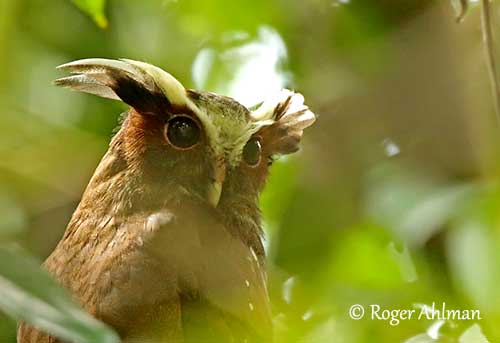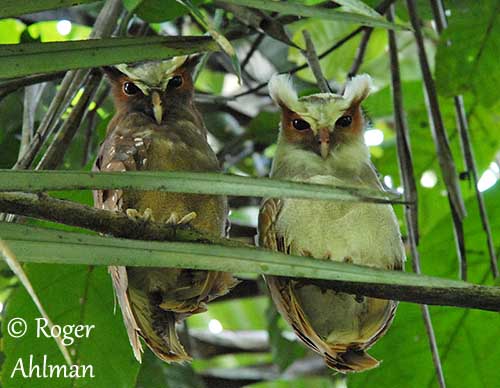
Fr : Duc à aigrettes
Ang : Crested Owl
All : Haubenkauz
Esp : Búho Corniblanco, Búho Crestado, Búho penachudo
Ita : Gufo dalla lunga cresta
Nd : Kuifuil
Sd : Tofsdvärguv
Port : Coruja-de-crista
Photographers :
Roger Ahlman
Pbase Galleries Peru and Ecuador
Steve Garvie
RAINBIRDER Photo galleries
Text by Nicole Bouglouan
Sources:
HANDBOOK OF THE BIRDS OF THE WORLD Vol 5 by Josep del Hoyo-Andrew Elliott-Jordi Sargatal - Lynx Edicions - ISBN: 8487334253
A GUIDE TO THE BIRDS OF MEXICO AND NORTHERN CENTRAL AMERICA by Steve N. G. Howell, Sophie Webb - Oxford University Press - ISBN: 0198540124
A GUIDE TO THE BIRDS OF COLOMBIA by Steven L. Hilty and William L. Brown - Princeton University Press – ISBN 069108372X
L’ENCYCLOPEDIE MONDIALE DES OISEAUX - Dr Christopher M. Perrins - BORDAS - ISBN: 2040185607
BirdLife International (BirdLife International)
Owling.com - The largest US website totally dedicated to owls
Crested Owl
Lophostrix cristata
Strigiformes Order – Strigidae Family
INTRODUCTION:
The Crested Owl is little-known and has distinctive appearance with the conspicuous white ear-tufts. This species is placed in the tribe “Strigini” which contains the wood-owls. It is restricted to the forested areas from SE Mexico to Brazil, and to Colombia, Ecuador and Peru.
DESCRIPTION OF THE BIRD:
Biometrics:
Length: 36-43 cm
Weight: 400-600 g
There are two morphs.
The adult in pale morph has buffy-brown to grey-brown upperparts. On the upperwing, the wing-coverts are spotted white.
The underparts are white with darker breast.
On the head, the facial disk is tawny to chestnut. The white eyebrows continue with long, erect, mostly white ear-tufts.
The adult in dark morph has dark brown upperparts, sometimes with reddish mottling. Wing-coverts and scapulars are spotted white. The primaries are barred buff and dark brown.
The underparts are tawny-buff with fine dusky barring and vermiculations.
On the head, the facial disk is dark rufous with blackish border. The prominent eyebrows and long ear-tufts are white.

SUBSPECIES AND RANGE:
The Crested Owl has three subspecies.
L.c. stricklandi occurs from S Mexico to W Panama and W Colombia.
This race has mostly blackish face and forehead, with dark rufous eye’s area. The long ear-tufts are white. The scapulars are white-edged. The eyes are mostly yellow-orange.
L.c. wedeli is found from E Panama to NE Colombia and NW Venezuela.
L.c. cristata occurs from S Venezuela and the Guianas to N Brazil, S through Amazonia to N Bolivia and N Mato Grosso, and then, W to SW Colombia, E Ecuador and E Peru.
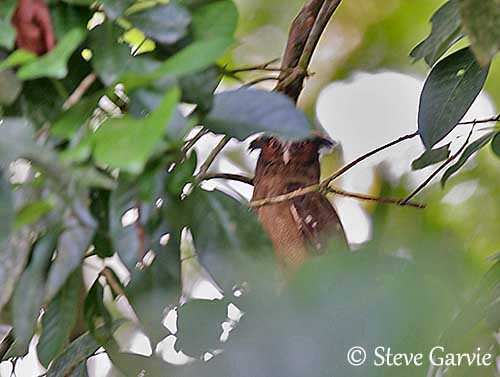
L.c. stricklandi
Costa Rica
HABITAT:
The Crested Owl frequents lowland rainforest with undergrowth, usually in primary forest, but now, also in tall second growth. It occurs in forest galleries and dense forests.
This species can be seen from sea-level up to 1200 metres of elevation in Guatemala, and up to 1900 metres in the cloud forest of Honduras.
It roosts by day in thickets and dense vegetation, often fairly low.
CALLS AND SONGS: SOUNDS BY XENO-CANTO
The Crested Owl produces a deep, frog-like croak repeated every 5-10 seconds “k,k,k,k,k,kkrrrrr” accelerating to a purr.
The race “stricklandi” gives shorter “gurr” or “ohrr” than the two other species.
They often call from the upper part of tall trees.
BEHAVIOUR IN THE WILD:
The Crested Owl is strictly nocturnal. It feeds primarily on large insects such as beetles and caterpillars, and probably other small invertebrates.
It can be seen perched along streams and at forest edge waiting for preys, but it hunts in the forest too.
The Crested Owl is a cavity nester. The breeding behaviour is poorly known. This species usually breeds in the dry or early wet season.
The male probably calls and sings to attract a female or to renew the pair-bonds. Courtship feeding by male to female is common in Strigidae. While offering food to the female, the male moves wings and body. These displays are performed prior to copulation.
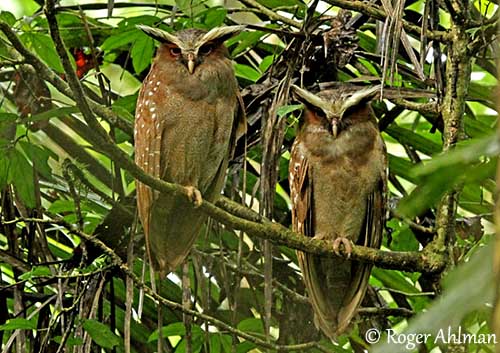
The Crested Owl is resident in its range.
Like other owls, it has silent flight due to the peculiar wing feathers.
REPRODUCTION OF THIS SPECIES:
The breeding season occurs between February and May.
The Crested Owl nests in holes in mature trees.
The eggs are probably white like in numerous cavity-nesters. The incubation by the female alone ranges between 30 and 35 days. After the hatching, the male does all of the hunting while the female attends the nest and the chicks.
The young birds usually remain with their parents at least until September.
PROTECTION / THREATS / STATUS:
The Crested Owl can be fairly common in several parts of the range, but its nocturnal habits make this bird difficult to study. The species is threatened by habitat loss and deforestation (Amazonian example), and declines are reported.
However, the Crested Owl has large range and it is currently evaluated as Least Concern.
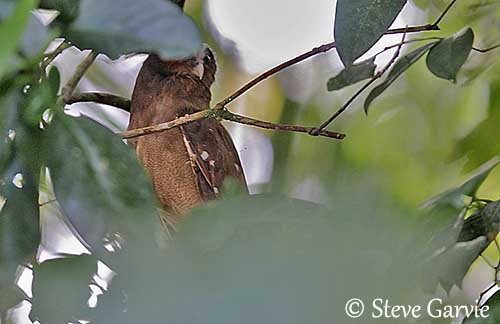
L.c. stricklandi
Costa Rica
The bill is yellowish-horn to dark horn. The eyes are usually dark brown-orange to yellow-orange. On the legs, the tarsi are feathered pale greyish-brown to the base of the toes. The claws are dark brown.
Both sexes are similar.
The juvenile has white body plumage, dark facial disk and short ear-tufts.
